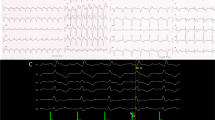Abstract
In patients with an accessory pathway close to the His bundle, radiofrequency catheter ablation (RFCA) requires additional care to avoid damage to the normal conduction system. To assess differences between approaches from above or below the tricuspid valve (TV), we performed RFCA in 20 dogs (from above, group A, n=10; from below, group B, n=10). RF energy with temperature control at 60° 60 seconds was administered at the site where a small His potential was recorded from the ablation catheter guided by fluoroscopy and transesophageal echocardiography (TEE) (in the latter six dogs). Before and after RFCA, electrophysiological testing was performed and histological findings were compared. An ablated lesion was created in 7 of 10 (2 of 2 guided by TEE) dogs in group A and 5 of 10 (3 of 4 TEE) dogs in group B. In group A, an ablated lesion involved the atrium and ventricle in the anterior site of His bundle, but the lesion was only in the ventricle in group B. An atrioventricular block (AVB) and severe damage to the penetrating bundle was observed in one dog of group A. A large hematoma on the TV was made in 2 dogs and the complete right bundle branch block (CRBBB) occurred in 3 dogs of group B. The approach from below the TV was safer than that from above the TV in parahisian RFCA, because it did not create an AVB, although it has a high incidence of CRBBB and associated technical difficulties.
Similar content being viewed by others
References
Jackman WM, Wang X, Friday KJ, et al. Catheter ablation of accessory atrioventricular pathways (Wolff-Parkinson-White syndrome) by radiofrequency current. N Eng J Med 1991;324:1605-1611.
Lesh MD, Van Hare GF, Schamp DJ, et al. Curative percutaneous catheter ablation using radiofrequency energy for accessory pathways in all locations: Results in 100 consecutive patients. J Am Coll Cardiol 1992; 19:1303-1309.
Calkins H, Langberg J, Sousa J, et al. Radiofrequency catheter ablation of accessory atrioventricular connections in 250 patients. Abbreviated therapeutic approach to Wolff-Parkinson-White syndrome. Circulation 1992;85:1337-1346.
Yeh SJ, Wang CC, Wen MS, et al. Characteristics and radiofrequency ablation therapy of intermediate septal accessory pathway. Am J Cardiol 1994;73:50-56.
Twidale N, Wang X, Moulton K, et al. Catheter placement for radiofrequency ablation of anteroseptal accessory pathways (Abstract). J Am Coll Cardiol 1991;17:231A.
Schlüter M, Kuck KH. Catheter ablation from right atrium of anteroseptal accessory pathways using radiofrequency current. J Am Coll Cardiol 1992;19: 663-670.
Kuck KH, Schlüter M, Gursoy S. Preservation of atrioventricular nodal conduction during radiofrequency current catheter ablation of midseptal accessory pathways. Circulation 1992;86:1743-1752.
Haissaguerre M, Marcus F, Porquet F, et al. Electrocardiographic characteristics and catheter ablation of parahissian accessory pathways. Circulation 1994;90: 1124-1128.
Reddy GV, Schamroth L. The localization of bypass tracts in the Wolff-Parkinson-White syndrome from the surface electrocardiogram. Am Heart J 1987; 113: 984-993.
Jackman WM, Wang X, Friday KJ, et al. Catheter ablation of atrioventricular junction using radiofrequency current in 17 patients. Comparison of standard and large-tip catheter electrodes. Circulation 1991;83:1562-1576.
Huang SK, Bharati S, Graham AR, et al. Closed chest catheter desiccation of the atrioventricular junction using radiofrequency energy?a new method of catheter ablation. J Am Coll Cardiol 1987;9:349-358.
Lopez-Merino V, Sanchis J, Chorro FJ, et al. Induction of partial alterations in atrioventricular conduction in dogs by percutaneous emission of high-frequency currents. Am Heart J 1988;115:1214-1221.
Huang SK, Bharati S, Graham AR, et al. Chronic incomplete atrioventricular block induced by radiofrequency catheter ablation. Circulation 1989;80: 951-961.
Nakagawa H, Wang X, Pitha J, et al. Comparison of lesions at the mitral annulus produced by radiofrequency ablation above and below the mitral leaflet (abstract). PACE 1992;15:583.
Hoyt RH, Huang SK, Marcus FI, et al. Factors influencing transcatheter radiofrequency ablation of the myocardium. J Appl Cardiol 1986;1:469-485.
Author information
Authors and Affiliations
Rights and permissions
About this article
Cite this article
Kato, R., Matsumoto, K., Goktekin, O. et al. Parahisian Radiofrequency Catheter Ablation in Dogs: Comparison of the above-valve and below-valve approaches. J Interv Card Electrophysiol 4, 359–368 (2000). https://doi.org/10.1023/A:1009814803581
Issue Date:
DOI: https://doi.org/10.1023/A:1009814803581




